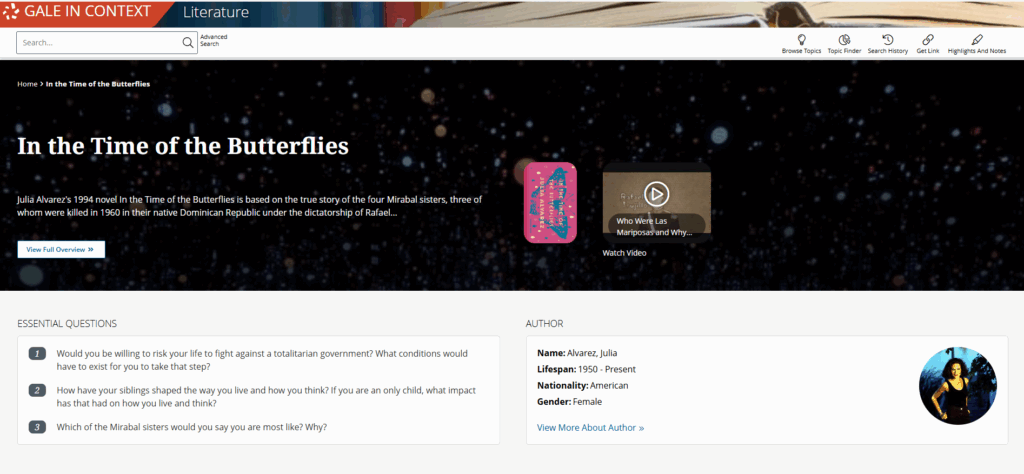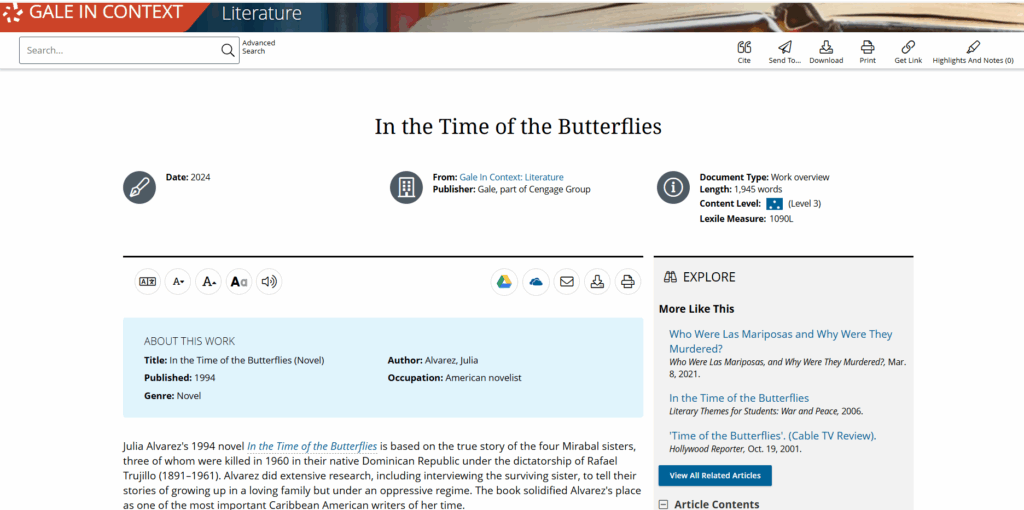Hispanic Heritage Month, observed from September 15 to October 15, provides educators with an opportunity to showcase the histories, cultures, and contributions of Latinx communities. In literature classrooms, exploring those contributions encourages students to think more critically about how Latinx authors use the written word to share stories of their communities and cultures while expressing their identities as individuals.
Latinx literature often breaks from expected patterns. For example, a story might switch between English and Spanish to capture how bilingual speakers think and interact with the world around them. In other instances, folklore might seamlessly weave itself in and out of history. For some students, these shifts challenge their assumptions about how literature should work. For others, they reflect lived experiences. Either way, these texts require thoughtful and informed engagement.
Gale In Context: Literature gives students the tools to meet that challenge. Its topic pages, reflective essays, multimedia resources, and critical thinking questions encourage learners to become more active, reflective readers while supporting teachers in guiding richer discussions. Let’s take a look at the works of four genre-spanning authors to explore how Gale supports deeper inquiry across a range of Latinx works, each paired with features that bring the text to life.
Structure as Meaning in The House on Mango Street
Sandra Cisneros’s The House on Mango Street follows Esperanza, a young Chicana girl growing up in a working-class Chicago neighborhood. Told through a series of brief, nonlinear vignettes, the book resists traditional storytelling. There’s no clear plot arc, no central conflict—just moments of insight into Esperanza’s experiences as a young woman and her desire for autonomy.
In the introduction for the book’s 25th anniversary reprint in 2009, Cisneros said of The House on Mango Street, “I still didn’t think of it as a novel. It was just a jar of buttons . . . I wrote these things and thought of them as ‘little stories,’ though I sensed they were connected to each other.”
Gale In Context: Literature gives students tools to engage with each of those “little stories” and their varying themes and constructions. After reading “Geraldo No Last Name,” for example, Gale offers a critical essay that digs into the “clipped and fragmented sentences that convey Marin’s sense of shock” when her dance partner dies after a hit-and-run.
Another critical essay, “The ‘Dual’ -ing Images of la Malinche and la Virgen de Guadalupe in Cisneros’s The House on Mango Street” gives religious, literary, and cultural context to Cisneros’s “And Some More,” in which two girls discuss snow. One girl, Lucy, states that there are only two kinds of snow: “the clean kind and the dirty kind.” Nenny responds “There are a million zillion kinds . . . No two exactly alike.” The essay positions this conversation as Cisneros pushing back against the idea that the world exists in clean-cut dichotomies of good versus evil.
To deepen that analysis, students can turn to Gale’s biographical video providing background on Cisneros then read “Two Conversations with Sandra Cisneros,” in which Bryce Milligan interviews the author as she reflects on the decisions that inform voice and structure in her body of work. Hearing directly from the author helps clarify the difference between Esperanza’s role as narrator and Cisneros’s work as a writer shaping that voice.
Activity Idea
Have students read Reuben Sánchez’s interpretation of the final vignette and mark the key evidence he uses. Then, watch the Cisneros interview and ask students to respond in writing: Where do Sánchez’s ideas align with Cisneros’s explanation, and where do they diverge? Use their reflections to open a conversation about how interpretation works when authors leave space for ambiguity.
In the Time of the Butterflies and the Politics of Memory
Julia Alvarez’s In the Time of the Butterflies tells the story of the Mirabal sisters—Patria, Minerva, and María Teresa—who risk their lives to resist the dictatorship of Rafael Trujillo in the Dominican Republic. Dedé, the only sister who doesn’t join the underground movement, survives the regime and becomes the keeper of their story. Alvarez shifts perspectives across chapters, allowing readers to see how each sister comes to resist and what it costs them, as well as those around them.
For students unfamiliar with the novel’s setting, references to the secret police, surveillance, and imprisonment of political prisoners can feel abstract and hard to grasp. Gale In Context: Literature helps ground those concepts through the Related Subjects linked in the novel overview. These include curated collections on the history of the Dominican Republic, military government, resistance movements, and more.
Each link opens a toolbox of relevant resources—from literary essays to historical background—that contextualizes the stakes without requiring an outside internet search that may lead to less reliable or biased information. Instead, students can rely on Gale as a trusted source of educator-vetted, standards-based material.
These connections let students explore questions in real time. When a chapter references “the SIM,” they can follow content linked under Related Subjects to understand the function of the secret police. When a character weighs the risk of rebellion, they can explore real-world examples of how authoritarian regimes punish dissent.
Activity Idea
After reading a chapter involving state violence or surveillance, have students explore an article linked under Related Subjects on the Topic Page. Then, ask them to write a short reflection: How does this background inform or expand their reading of Alvarez’s work? Use their responses to initiate a discussion about how context influences our perception of what is right, necessary, or courageous. For example, guerrilla warfare might sound reckless and violent—but are there circumstances in which it could be necessary for change? And what of the people fighting on behalf of a repressive regime? It might seem cowardly, but what if their family is under threat?
Interpreting Magical Realism in One Hundred Years of Solitude
In One Hundred Years of Solitude, Gabriel García Márquez tells the story of a town that seems to exist outside of time. Through the rise and fall of seven generations of the Buendía family, he layers the ordinary with the surreal. The novel opens with a firing squad and closes with a prophecy fulfilled—but in between, time loops, ghosts linger, a plague of insomnia descends upon a town, and characters live for centuries. These events are delivered in a matter-of-fact tone that neither explains nor justifies the high strangeness of it all.
Gale In Context: Literature provides students with multiple ways to engage with the complexity of One Hundred Years of Solitude without oversimplifying it. For example, the interactive character map clarifies the Buendía family’s complex and intricate intergenerational tangle. Similarly, students can return to the plot summary as a foothold when events become unclear or loop back. In both cases, these scaffolds free up class time for more advanced interpretive work.
To support genre analysis, Gale’s reference entries on magical realism and postmodernism help students understand what García Márquez is doing within the context of these genres: depicting miraculous events in understated terms and removing the narrator as an interpretive guide.
The result is a narrative that resists fixed interpretation, leaving space for the reader to either surrender to its logic or construct meaning where the text remains silent. That ambiguity creates fertile ground for classroom discussion, where multiple interpretations can coexist while students learn to support their readings through text-based evidence.
If students need to strengthen their understanding of key background information, the Crash Course Literature video offers a fast-paced, accessible overview of key concepts like cyclical time and magical realism in the context of the novel.
Activity Idea
Anchor a genre study in One Hundred Years of Solitude, then introduce two of Márquez’s short stories—“A Very Old Man with Enormous Wings” and “The Handsomest Drowned Man in the World.” Each features an outsider disrupting village life, but the tone and ambiguity vary sharply. Have students compare how these texts guide interpretation or deliberately withhold it. Prompt students to explore how magical realism creates emotional and narrative distance, and why that distance matters in stories shaped by memory and myth.
Gary Soto and the Poetics of Masculine Restraint
Gary Soto’s work returns, again and again, to quiet moments that feel inconsequential but are, in reality, experiences fundamental to the process of growing up. A boy tries to build his confidence before a first date. A teenage speaker and his friend watch the world go by, imagining escape while doing nothing to bring it closer. Across his poems and short stories, Soto doesn’t dramatize feelings. He writes around it, allowing silence, gesture, and withheld language to do the emotional work.
This kind of emotional containment reflects a cultural logic many students will recognize: the expectation that masculinity requires composure and that visible softness should be minimized or avoided.
Gale In Context: Literature’s biographical entries provide background into the author’s childhood growing up in a working-class, Mexican-American neighborhood in Fresno, losing his father at age five, and working in the fields as a teenager. Soto’s work, in particular, invites discussion of machismo, the expectation that men express their masculinity through bravery, decisiveness, and acts of aggression rather than emotional vulnerability. While the term is rooted in Latinx cultural tradition, the pattern it describes cuts across identities. Students may see aspects of machismo in themselves and in the behaviors or expectations that influence their relationships with family members or peers.
Gale’s literary criticism archive builds on this cultural context. In “Poetry and Masculinity on the Anglo/Chicano Border,” Michael Manson positions Soto’s work alongside Robert Frost and Robert Hass, noting that Soto’s male characters tend to resist vulnerability with detachment. They’re not unfeeling; they’re protective. “Ambiguity in the Poetry of Gary Soto” by Patricia de Fuentes pushes further, suggesting that Soto’s resistance to emotional resolution becomes a method of meaning-making. The refusal to name emotion in these texts is itself expressive.
Students can hear this restraint articulated in Soto’s own voice through a brief audio commentary, where he reflects on how sentiment in poetry must be handled deliberately rather than insincerely.
Activity Idea
Assign two of Soto’s works—the poem “Oranges” and the short story “Looking for Work,”— and ask students to consider how Soto conveys emotion without explicitly stating it. Then, introduce Robert Frost’s “Death of a Hired Man” or Robert Hass’s “The World as Will and Representation.” Invite students to consider how both Soto and the poets portray emotional complexity through the use of withholding. What do these texts ask the reader to infer?
Inspire New Perspectives in the Classroom with Latinx Storytelling
Whether students are unraveling the fragmented structure of The House on Mango Street or navigating the layered surrealism of One Hundred Years of Solitude, Latinx-authored texts reward sustained and attentive reading. They challenge assumptions not only about language or culture, but about how stories reveal meaning.
Gale In Context: Literature equips students to meet that challenge. By pairing essential texts with critical essays, genre analysis, author context, and multimodal resources, the platform supports deeper inquiry without reducing complexity. When students engage with texts that resist clarity—through ambiguity, nonlinear structure, or emotional restraint—they’re given both the scaffolding and the intellectual freedom to construct meaning on their own terms.
Learn more about the value of Gale In Context: Literature in high school classrooms during Hispanic Heritage Month and beyond by reaching out to your local Gale sales representative.



